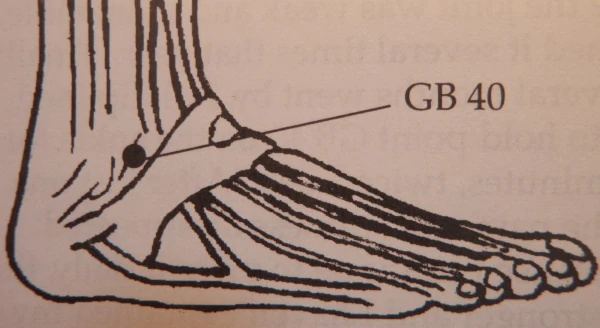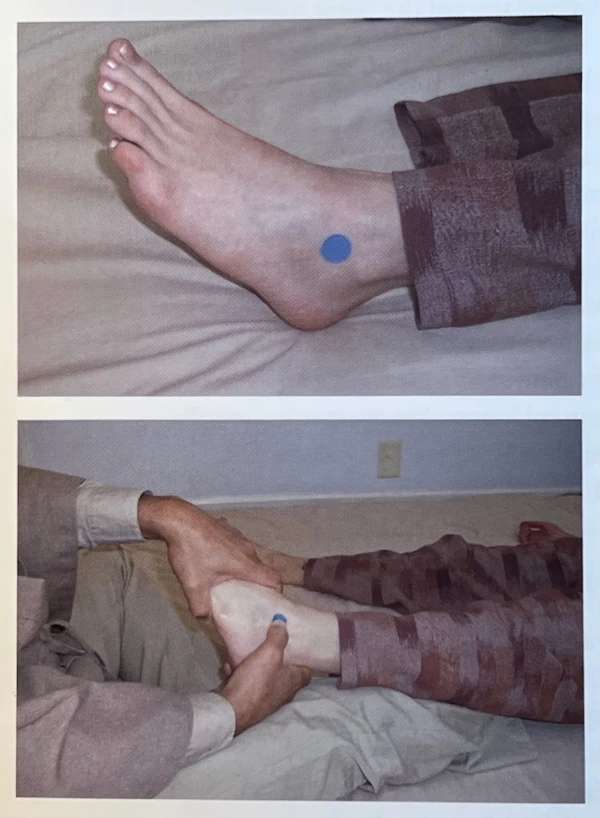Thai Massage Techniques Integrated With Acupressure
Thai massage sessions are done with the person sitting in a chair or lying down either on their side, their back, or face down. Traditional Thai massage techniques activate various Acupressure points using the fingers, palms, forearms, elbows, knees, feet, and toes. These varied therapeutic stretching methods trigger the body’s natural self-curative abilities.
Thai massage stretches, similar to assisted yoga postures, stimulate the healing energy pathways known as sen, which are are called meridians in Traditional Chinese Medicine. A wide variety of wonderful Thai massage stretching techniques focus only on the stretches themselves.
Even though Acupressure points along the sen lines are stimulated naturally, why not purposely incorporate therapeutic Acupressure? As we engage our clients in assisted therapeutic stretching, we’ll find many opportunities to apply deep finger pressure into specific points.
For example, if we are holding our client’s feet and pulling them toward us to bring about a lower back opening, can we use our fingers and thumbs to press strong Acupressure points nearby as we execute the stretch? In many instances, the answer is yes.
Performing a Thai massage, can integrate knowledge of Chinese Acupressure into routines and stretches. In most cases, these two ancient healing systems work very well together. The combination results in enhanced pain relief and increased health benefits.
Sen Lines, Nadis & Meridians
Acupressure relaxes muscular tension and balances the vital life forces of the body that run through energy channels. These pathways are known as Thai sen lines, Indian nadis, and Chinese meridians. The Acupressure points are found along these energy channels, and are often where this healing energy gets stuck.
When tension collects around these Acupressure points, working with them creatively and sensitively is important in order to effectively relieve tension. The points are keys to unblocking the flow of the vital life force, so it can move freely through the energy pathways. As points release and energy flows, the muscles relax so that the Thai massage stretches can be even more effective.
This vital energy is the source of life, and its flow is the key to radiant health. This energy is known as chi or qi in Chinese medicine, ki in Japan, prana in the Indian Ayurvedic system, and lom in traditional Thai medicine. This life force energy flows through the energy channels and benefits the entire body. It regulates all the organs and systems, such as the glands, nerves, and muscles, and also harmonizes our emotional and mental states.
The stimulation of specific points in Thai massage opens the body’s natural homeostatic, or balancing, mechanisms. Acupressure directly reduces tension and stress and allows the body to heal itself more effectively. Acupressure creates a feeling of health and well-being. When our energy is flowing properly, we feel alive, happy, peaceful, and in harmony with ourselves and others.

Emotional & Spiritual Healing
A hurtful emotional incident can cause the muscles to contract, like protective armor, in order to shield the inner self. Spiritual aspects of our lives may also shut down, causing depression, apathy, and diminished self-awareness. Many therapies deal with the mental and emotional aspects of trauma, but do not deal with the physiological component. Thus, there is a limitation to those approaches.
Thai massage and Acupressure have a distinct advantage over such therapies, since they work directly with the energetic core and the mind-body connection. Both Acupressure and Thai bodywork can relax the tight muscles that result from emotional disorders and stress-related problems.
By freeing unresolved emotional experiences stored in the body, many everyday complaints can also be alleviated. Examples are headaches, insomnia, sluggishness, and depression. When healing energy flows, anxiety turns to calmness, encouraging physical health and overall wellness.
Thai Massage With Acupressure
When working with Thai massage, try to constantly stay aware of the points that your hands can hold, as well as the other points that are being released in each Thai technique or stretch. As you incorporate Acupressure with Thai massage, you'll find the integration more and more natural and easy.
When you know the therapeutic values of the points used in Thai techniques, you can intensify the benefits of individual Thai postures. Therefore, you can enhance a traditional Thai massage session by integrating more Acupressure. This can be done while staying true to traditional Thai techniques and postures.
Client’s Insight
A client of Michael's, who also practices Thai massage once described one of his Thai sessions in this way: “As you engaged me in a standard Thai massage posture and slowly brought me into a full body stretch, you began to gradually apply firm pressure on Acupressure points that were totally unknown to me.”
He continued, “I could tell you knew exactly what you were working on, and although I was enjoying the Thai stretch, it was the combination of the stretch plus the strong Acupressure that brought about the entire healing effect.”
Common Bodywork Outlook
Both Thai massage and Acupressure relieve muscle tension and balance the vital life energy of the body. Acupressure does this by manipulating body energy through a system of points and meridians.
In Thai massage, we compress and stretch areas of the body that may be blocked, and also use pressure on Acupressure points. The stretches used in Thai massage naturally stimulate specific points during a session. This is similar to the way yoga postures activate these same healing points.
Therapeutic Stretching With Acupressure Points
Even if you were taught to execute a certain Thai yoga stretch without applying simultaneous Acupressure, it can still be helpful to hold specific points within your reach as you execute the stretch. A Thai massage practitioner’s ability to facilitate healing can be furthered by knowing which basic Acupressure points to use in this way, and what their specific benefits are.
If your Thai massage training didn’t incorporate extensive knowledge of individual Acupressure points from within the body of Thai medicine, you may research some of the points referenced by Wat Pho, Asokananda, and Noam Tyroler, or search out Northern Thai (Lanna) points from other sources. Fortunately, these days more Acupressure is being integrated into current-day Thai massage teaching.

Acupressure Points for Enhancing Thai Massage Techniques
Stimulating Acupressure points while engaging a client in Thai massage stretches can bring positive results. Although the Chinese and Thai medicine systems vary greatly, many points are known to both healing systems. Examples include the points used in the exercises below.
Thai Acupressure is not usually done while clients are simultaneously engaged in yoga stretches, suspensions, inversions, and other Thai bodywork applications, but I suggest that you consider doing so. As clients surrender to powerful Thai stretches, working Acupressure points within your reach can heighten their experience and bring greater results.
Enhanced awareness and grounding is a major result of receiving a well-balanced Thai massage session. This clarity fosters peace of mind and calmness, and by extension, it positively affects other pursuits in life. In learning about the body’s Acupressure points and energy channels, an individual’s healing paths can unfold to their fullest potential.
Integrating Acupressure With Thai Massage
Once you learn how to find the points, then holding a point or two while practicing Thai massage can be easy and natural. If it feels awkward to grasp the points while doing a Thai technique, simply turn your hand to a new position. For instance, if you are holding a point and it feels awkward or uncomfortable, try turning your hand so that your palm faces a different direction.
You could also change from using your thumb to using your fingertips or vice versa. Any shift in position will give you a completely different approach to holding the point. The correct way to hold a point will feel natural. Practice the most comfortable ways to hold the points, and you’ll discover how easy and intuitive this holistic integration can become.
Acupressure & Thai Massage Exercises
The following examples are only a few of the many traditional Thai massage postures that allow for simultaneous stimulation of Acupressure points. The Thai postures themselves have specific therapeutic values. However, when Acupressure points are integrated into each technique, there are increased benefits.
The points mentioned here are in accordance with Traditional Chinese Medicine, the base of knowledge for Acupressure. Try them, and get feedback from your clients.
How to Apply Pressure
Every individual body and each area of the body requires a different amount of pressure. If your client shows signs of pain or discomfort when you apply pressure on a particular point, then use a lighter touch, or use palming instead of thumb pressure. The calves, face, groin, and abdomen are generally more sensitive to pressure.
The back, buttocks, and shoulders usually need a deeper, firmer pressure, especially if the musculature is developed. Traditional Thai massage postures provide an excellent platform for applying deeper pressure to these areas by using your whole body to lean in, while allowing the receiver to stretch and breathe deeply.
Leg Twist and Pull
Directions: Grasp the foot, twisting it medially, and pull the leg backward as you lean back. As you grasp the top of the foot with one hand, place your thumb on the large indentation in front of the ankle bone. Twist the foot inward, and and gradually apply firm pressure into the hollow of the point as you lean back slowly to stretch the leg. Every time you lean back, engage the Acupressure point.

Acupressure Benefits: This point, GB 40, balances the gall bladder and is an excellent point for strengthening the ankle joint. It’s good for relieving headaches and sciatica. This outer ankle point prevents and relieves ankle sprains and any sciatic pain which travels into the side of the foot.
This point also balances a generally tight and stiff body, and relieves aches and pains, especially along the side of your body. In addition, you can use this GB 40 point to decrease a client’s overall frustrations and irritability.
Foot Walking on Backs of the Thighs
Directions: With the client lying on his or her back, with one leg bent outward at 90-degrees, the practitioner sits between the client’s legs with the soles of his or her feet on the back of the thigh on the client’s bent leg.
Instead of gripping the foot, as you do this traditional Thai Foot Walk, thumb press the indentation that lies midway between the protrusion of the inside anklebone and the Achilles tendon. Once you are on the inner ankle point, begin the “foot press” or “foot walk.”

Acupressure Benefits: This inner ankle point, K 6, point relieves swollen feet, body fatigue, emotional fears and phobias, and bed wetting. It also balances sexual problems such as premature ejaculation, semen leakage, genital pain, vaginal discharge, and menstrual irregularity. Avoid stimulating this point on a pregnant woman.






